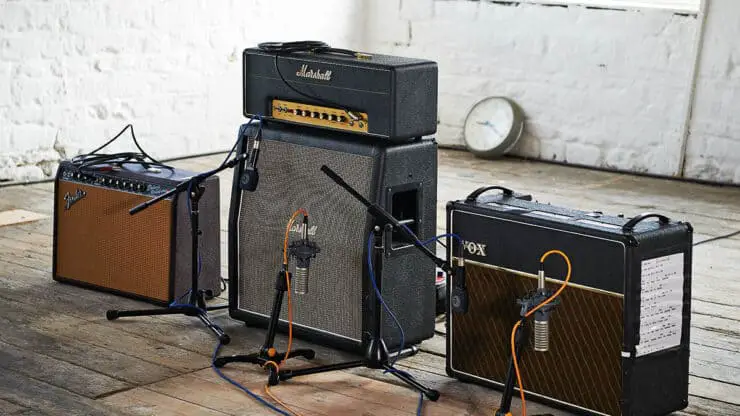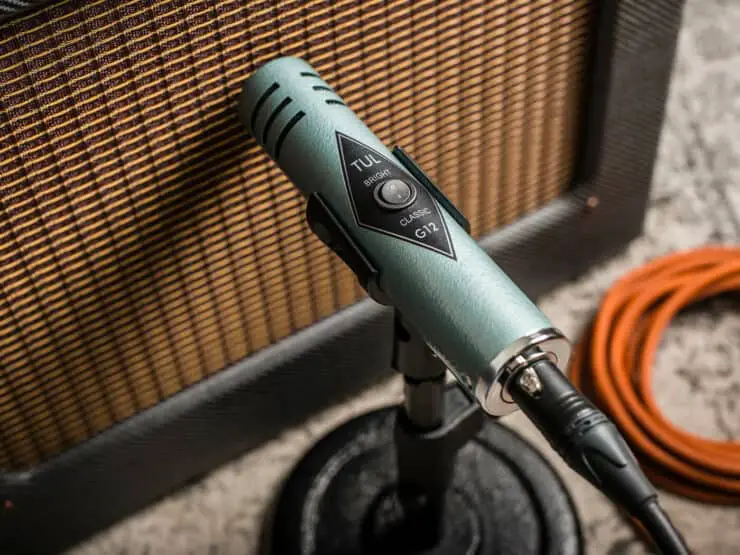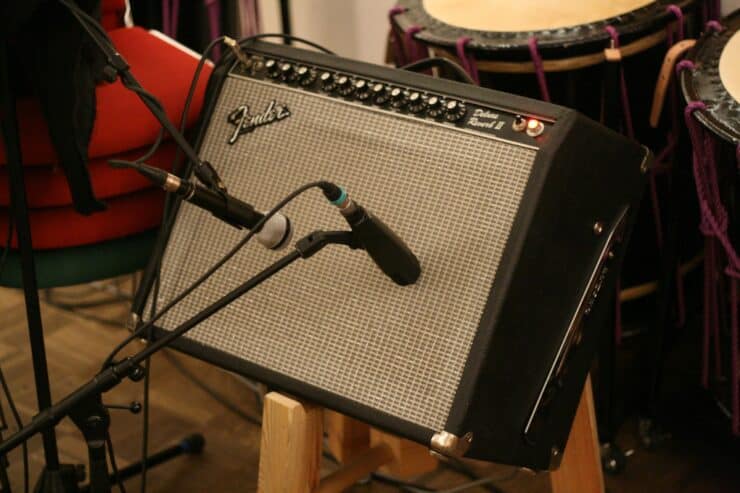Are you a guitarist looking for the ultimate sound? Do you want to know the best way to mic your guitar amp? This article will provide an overview of the different techniques used to mic a guitar amp and how to get the best sound from your equipment. Read this article to learn the best way to mic your guitar amp and achieve that professional sound.
What is microphone placement?
In the world of audio recording and live sound reinforcement, microphone placement plays a key role in capturing the best possible sound. It refers to the technique of positioning a mic in relation to a sound source to achieve optimal audio quality, balance, and desired tonal characteristics. Proper mic placement is important for capturing clear and accurate recordings whether in a studio environment or during live performances.
>>> Click here to read our review about the Top 15 Best Guitar Amps <<<
Microphone placement involves strategic positioning of the microphone for achieving the desired sound. The placement will depend on factors like the type of mic being used, the sound source, the desired tonal quality, the recording environment, and more. Each of these factors significantly affects the overall tone captured by the mic. By carefully positioning the microphone, the musicians and guitarists are able to control the sound’s clarity, balance, presence, and other sonic characteristics.
One of the main goals of microphone placement is to capture the sound source accurately and without any distortion. Improper placement can result in audio issues such as phase, cancellation, proximity effect, and unwanted background noise. For instance, placing a microphone too close to a source might result in distorted recordings or exaggerated low-frequency responses due to the proximity effect, which boosts bass frequencies. Meanwhile, positioning the mic too far away might introduce unwanted room reflections or result in a weak and distant sound.
Microphone placement also plays a key role in achieving balance and separation in a mix. In multi-microphone recording scenarios, proper placement will help minimize bleed or unwanted sound pickup from other sources. This will allow for greater control during the mixing process, allowing engineers to adjust individual track levels and apply processing to achieve a well-balanced and cohesive mix.
Moreover, it also affects the tonal characteristics of the recorded sound. Different microphone placement techniques like close-miking, XY stereo, spaced pair, etc. yield different results in terms of tonal balance and stereo imaging. By experimenting with different placement techniques, musicians and guitarists will be able to shape the character of the recording to match the desired artistic vision or genre.
In live sound reinforcement, microphone placement will be important for achieving clear and balanced sound in a performance venue. Properly positioned microphones help capture the intended sound from each instrument or vocalist, reducing feedback and ensuring the best possible sound quality for the audience.
It is also important to note that microphone placement is not a one-size-fits-all approach. It needs careful listening, experimentation, and experience to determine the most suitable position for each specific recording or performance scenario.

What is the best way to mic a guitar amp?
When it comes to capturing the perfect sound from a guitar amp, properly miking the amp is an important step. There is a set of rules that will help you make a significant difference in capturing the desired tone and capturing a quality guitar recording. If you’re wondering what is the best way to mic a guitar amp, then here are the steps you’ll need to follow. These steps will allow you to effectively mic a guitar amp, ensuring optimal sound capture, and an excellent audio result.
Step 1: Choose the right microphone
Selecting the appropriate microphone for miking a guitar amp will be important for achieving the desired sound. Dynamic and condenser mics are commonly used for this purpose.
Dynamic microphones, such as the industry-standard Shure SM57, are renowned for their versatility, durability, and ability to handle high sound pressure levels. They’re quite a popular choice for miking guitar amps due to their ability to capture the amp’s characteristics and handle the volume levels generated by guitar amps.
Condenser microphones offer enhanced sensitivity and accuracy, which makes them suitable for capturing the fine nuances and tonal characteristics of the guitar amp. They are particularly useful in studio environments or when capturing a more detailed and pristine sound. Condenser mics might require phantom power, so make sure your audio interface or mixer can provide it if using a condenser mic.
Step 2: Proper placement
Once you’ve chosen the right mic, placing it correctly in relation to the guitar amp will be critical for achieving the desired sound. Experimentation and personal preference play a major role in finding the sweet spot.
First, you should position the mic close to the speaker cabinet for a more direct and focused sound. Placing it near the center of the speaker cone tends to result in a brighter tone while moving it towards the edge can yield a mellower sound.
Angle the mic slightly off-axis from the speaker cone to capture a balanced frequency response and reduce harshness. Experiment with different angles to find the sweet spot that suits your taste.
Distance from the speaker cone will impact the sound as well. Placing the mic closer to the speaker produces a more focused and present sound while moving the mic further away will capture more room ambiance and create a sense of space. Experiment with different distances to find the desired balance.
Step 3: Adjust the microphone settings
Lastly, you will need to properly adjust the microphone settings when it comes to miking a guitar amp. Start off with the microphone gain or input level. Set the gain to an appropriate level that captures the desired sound without introducing distortion or clipping. Monitor the levels and then adjust as required for achieving a clean and balanced signal.
You should then consider the polar pattern of the microphone. Dynamic mics like the SM57 have a cardioid pattern, which means they are most sensitive to sound from the front and reject sound from the sides and rear. Adjust the positioning and angle of the mic accordingly to optimize the polar pattern and capture the desired sound source.
If using a condenser mic, make sure that phantom power is engaged on your audio interface or mixer if needed by the microphone. Adjust any additional settings specific to the microphone model, such as low-cut filters or pads for achieving the desired sound.
Remember to monitor the sound through quality studio monitors or headphones to make real-time adjustments and fine-tune the microphone placement and settings as needed.
By following these steps and paying close attention to microphone placement, you’ll be able to effectively mic a guitar amp and capture its unique sound. Experimentation, patience, and listening critically will be key to finding the sweet spot that perfectly captures the character and tones of the guitar amp, whether in live performances or recording sessions. With practice and attention to detail, you’ll be able to achieve stellar guitar amp recordings that showcase the true essence of your guitar playing.
Benefits of proper microphone placement
In the world of guitar recording, audio production, and live sound reinforcement, proper microphone placement is a fundamental technique that greatly impacts the overall quality and control of the sound. Microphone placement refers to the strategic positioning of microphones in relation to sound sources and plays a vital role in capturing clear, accurate, recordings and delivering optimal sound reinforcement during live performances. Here are some of the primary benefits of proper microphone replacement –

#1. Improved sound quality
One of the main benefits of proper microphone placement is improved sound quality. By positioning the microphone in the ideal location, musicians and guitarists will be able to capture the intended sound source accurately and without distortion. This will ensure that the nuances, details, and tonal characteristics of the instrument or voice are reproduced faithfully, resulting in a high-quality audio recording or live sound reproduction.
#2. Enhanced clarity and presence
Proper mic placement allows for capturing the desired sound with clarity and presence. By finding the optimal position, musicians and guitarists will be able to minimize unwanted background noise, room reflections, and bleed from other sources. This will help maintain focus on the primary sound source, allowing it to shine through in the mix and provide a more defined and articulate sound.
#3. Control over balance and separation
Microphone placement offers control over the balance and separation of sound sources in the mix. By positioning the mics carefully and managing their proximity to different instruments or vocalists, you’ll be able to achieve better separation and reduce bleed between channels.
This will enable greater control during the mixing process, allowing individual tracks to be adjusted, equalized, and processed independently to achieve a well-balanced and professional-sounding mix.
#4. Flexibility and artistic expression
Proper microphone placement will provide flexibility and artistic expression in capturing sound. Different microphone techniques like close-miking, stereo configurations, spaced pair, and more offer distinct sonic characteristics and tonal options.
By experimenting with different placement techniques, you’ll be able to shape the sound to match the desired artistic vision, genre, or recording style. This will allow for creative exploration and the ability to capture unique and engaging audio experiences.
#5. Minimized feedback and unwanted noise
Another benefit of proper microphone placement is the reduction of feedback and unwanted noise. By placing microphones strategically and considering the polar patterns and sensitivity of the microphones, you will be able to minimize the risk of feedback. This can be quite problematic in live sound reinforcement.
Moreover, by avoiding placement near sources of unwanted noise or interference, engineers will be able to maintain a clean and clear signal, resulting in a much more enjoyable and immersive audio experience.
#6. Consistency and reproducibility
Another benefit of proper microphone placement is that it will help you achieve consistency and reproducibility in audio recordings or live performances. Once an ideal mic placement is achieved, it can be replicated across different sessions or performances, ensuring a consistent sonic character. This is especially important when working on multi-track recordings or when trying to recreate a specific sound for live performances.

Different types of microphones
Microphones are essential components in your recording setup that allows you to capture and amplify the sound of your vocals or instruments like a guitar. There are different types of microphones available in the market with each type coming with its distinct features. Here are the different types of microphones you will find in the market and their unique features, strengths, and common applications.
Dynamic microphones
Dynamic microphones are rugged and versatile, which makes them a popular choice for different applications. These mics work on the principle of electromagnetic induction, where sound waves cause a diaphragm attached to a coil to move within a magnetic field. This movement generates an electric signal, capturing the sound. These microphones are known for their durability, reliability, and versatility.
Dynamic mics are known for their robust construction, making them resistant to rough handling, high sound pressure levels, and environmental conditions. They are often used in live sound applications, such as concerts and outdoor events where durability is important.
They are also less sensitive to moisture and humidity, making them reliable in challenging environments. They are able to withstand high volume levels without distortion, making them suited for capturing loud sources like drums and guitar amps.
Dynamic mics excel at handling high-volume sound sources, making them suited for live performances, instrument amplification, podcasting broadcasting, and general-purpose recording. Their ability to handle loud sources and their durability make them popular choices for stage performances and studio recordings.
Condenser microphones
Condenser microphones are known for their sensitivity and accuracy, which makes them ideal for capturing subtle details and nuances. They work on the principle of capacitance, where sound waves cause vibrations in a thin diaphragm placed in close proximity to a charged backplate. This variation in capacitance generates an electrical signal, capturing the sound. Some of the main characteristics of condenser mics include sensitivity, extended frequency response, and more.
Condenser mics are highly sensitive, which allows them to capture the finest details and subtle nuances of a sound source. This makes them suited for capturing vocals, acoustic instruments, and studio recordings that require high fidelity and clarity.
They typically have a wider frequency response compared to dynamic mics, allowing them to capture a broader range of frequencies accurately. This makes them suited for capturing instruments with extended frequency range, such as guitars and orchestral instruments.
Most condenser mics need phantom power, which is typically supplied by audio interfaces, mixing consoles, or dedicated power supplies. This additional power enhances the sensitivity and overall performance of the mic.
They’re widely used in professional studio recording, podcasting, broadcast application, voice-over work, and capturing acoustic instruments and vocals. Their ability to capture fine details and reproduce accurate sound makes them a staple in professional audio production.
Ribbon microphones
Ribbon microphones are known for their smooth and natural reproduction. These microphones work on the principle of a thin metal ribbon suspended within a magnetic field. When sound waves cause the ribbon to vibrate, it generates an electrical signal, capturing the sound. Some of the key characteristics of ribbon mics include warm and natural sound, delicate construction, and bidirectional polar pattern.
These microphones come with a warm and smooth sound reproduction, often described as vintage or classic. They offer a gentle high-frequency roll-off, capturing sound sources with a pleasing and natural tonal balance.
Ribbon mics are delicate and sensitive to rough handling, wind blasts, and high sound pressure levels. They need careful handling and protection to avoid damage to the fragile ribbon element. Most ribbon mics exhibit a bidirectional polar pattern, capturing sound from the front and back while rejecting sound from the sides. This pattern makes them perfect for capturing a sound source in front of the microphone while minimizing unwanted off-axis noise.
They are commonly used in studio recordings, broadcasting, and sound reinforcement applications where a vintage or smooth sound is desired. They are particularly suitable for recording vocals, strings, and bass instruments, and capturing room ambiance.
Tips to get the best sound from your guitar amp setup
Creating an exceptional guitar tone needs more than just a great amplifier. Properly utilizing microphones, DI boxes, and preamps greatly enhance your guitar amp setup and help you achieve the best sound possible. Here are the different tips on how you can get the best sound and performance from your guitar amp setup.
#1. Using multiple microphones
Using multiple microphones can add depth, dimension, and versatility to your guitar sound. When using multiple microphones, you can experiment with different microphone combinations, position the microphones strategically, and blend the microphone settings.
Try using a combination of dynamic, condenser, and ribbon mics to capture various tonal qualities. Dynamic mics like the industry-standard Shure SM57 excel at handling high sound pressure levels and capturing the sound of guitar amps. Condenser mics provide enhanced sensitivity and accuracy, capturing fine details, and nuances. Ribbon mics offer a vintage and smooth sound character. Combining different microphone types will yield a rich and balanced guitar tone.
Experiment with microphone placement to find the sweet spots that best capture your desired sound. Place dynamic microphones close to the speaker cone for a focused and direct sound. Try to position condenser or ribbon microphones a bit further away to capture room ambiance and add a sense of space. Vary the angle and distance from the speaker cone for fine-tuning the tonal characteristics. Remember that you should consider phase relationships and experiment to find the best combination and placement for your setup.
Use a mixer or audio interface with multiple inputs to blend the signals from different microphones. Adjust the levels of each microphone to achieve a balanced and well-rounded sound. Pay close attention to any phase cancellation issues that might arise from combining multiple microphones and adjust the position or polarity accordingly. Blend the signals creatively for achieving the desired sonic character and add depth to your guitar tone.
#2. Using DI boxes
Direct Input boxes or DI boxes are useful tools for connecting your guitar amp to recording interfaces or PA systems. You can maximize their potential by following measures like maintaining a clean signal, utilizing the ground lift feature, and more.
DI boxes convert the high-impedance guitar signal to a low-impedance balanced signal, ensuring a clean and noise-free connection. Connect your guitar directly to the DI box for preserving the integrity of the signal before it goes into other audio equipment.
DI boxes often come with a ground lift switch that can help eliminate ground loop hum and unwanted noise. If you encounter any noise issues, try to engage the ground lift switch to see if it resolves the situation.
Some DI boxes also offer additional features like attenuation pads, phase switches, or tone-shaping options. Try experimenting with these features for optimizing your guitar signal and tailoring it to your specific requirements.
#3. Using a preamp
Preamps play a key role in shaping and amplifying your guitar signal. To make the most of a preamp, you can experiment with gain and tone settings, match impedance levels, and use the preamp’s coloration wisely.
Preamps offer gain and tone controls that allow you to shape the guitar’s sound. Adjust the gain for achieving the desired level of overdrive and distortion. Explore the tone controls for shaping the frequency response and finding the sweet spots that enhance your guitar tone.
Make sure that the impedance of your guitar matches the input impedance of the preamp for optimal signal transfer. Mismatches in impedance can result in tone loss or changes in frequency response. If needed, make use of impedance-matching devices or consult the equipment specifications for proper impedance matching.
Some preamps are known for their unique tone coloration or sonic characteristics. Experiment with different preamps for finding the one that complements your guitar and desired sound. Consider using preamps with tube circuitry for added warmth and richness.
FAQs
What are the different types of microphones used for micing a guitar amp?
The most commonly used types of microphones for micing a guitar amp are dynamic, condenser, and ribbon microphones. Dynamic mics are typically used for micing guitar amps as they are able to handle high sound pressure levels and are relatively inexpensive. Condenser mics are often used for capturing a more detailed sound, but require a significant amount of gain to operate. Ribbon mics are known for their warm and natural sound and can provide a more subtle and nuanced tone when micing a guitar amp.
What should I consider when micing a guitar amp?
When micing a guitar amp, it’s important to consider the type of microphone, the distance of the mic from the amp, and the positioning of the mic. Different types of mics will produce different tones, so it’s important to find the right type of mic for the sound you are trying to achieve. The mic should also be positioned in the right spot to get the desired sound, and the distance of the mic from the amp should also be considered.
What are the benefits of micing a guitar amp?
Micing a guitar amp can provide a more detailed sound compared to using an amp alone.



